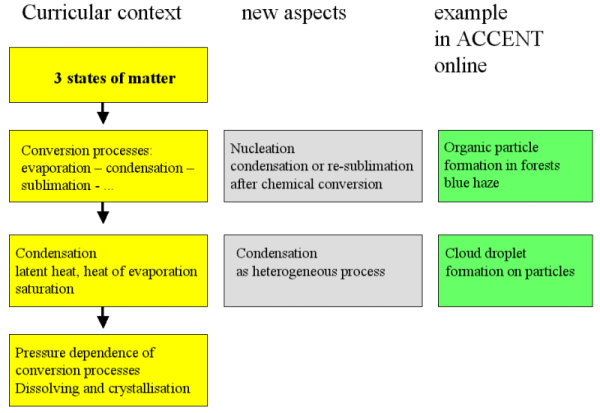
> ACCENT en > Nr 2 June 2005 forest/aerosols > I: Information for Teachers
|
|
 |
Information for Teachers |
|
Solutions and further information:
Find further material and solutions in the ACCENT material corner for this edition.
What are pupils expected to learn?
The content of this online magazine can be integrated in the context of studying physical states of matter: gaseous liquid and solid, conversions between states, caloric processes and solvation. Such processes are observed in the natural environment.
- Students will understand that not only water but also other chemical compounds can change their state of aggregation.
- Students will learn that conversion in the atmosphere is not only a physical processes of one compound which is always there in one of its states, but also chemical processes are taking place.
- Students will learn about saturation and the conditions for condensation of water in the air.
- Students will see, that particles are essential for cloud condensation and therefore have a climate impact.
- Students will see, that conversion processes require energy and energy and calorific properties play an important role in weather and climate phenomena.
|
|
Curricular context
The content of this ACCENT online material can for example be integrated as application in classes in the context of
- states of aggregation (gaseous, liquid, solid) and the conversion between them
- calorific processes and energy uptake and transport (solvation, heat uptake, thermal expansion)
- condensation, saturation and relative humidity (discussion also of oversaturation)
States of aggregation and conversion processes are essential contents in physics and chemistry classes. The specific conditions for condensation processes however are not always discussed and treated here.
If discussing climate relevance of calorific processes and heat transport in more detail, the thermal expansion of water as reason for sea level rise may be mentioned and heat differences as driving factor of global wind systems.
|
 > ACCENT en > Nr 2 June 2005 forest/aerosols > I: Information for Teachers
> ACCENT en > Nr 2 June 2005 forest/aerosols > I: Information for Teachers
